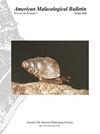Effects of Density and Food Deprivation on Growth, Reproduction, and Survival of Lissachatina fulica
IF 0.4
4区 生物学
Q4 MARINE & FRESHWATER BIOLOGY
引用次数: 2
Abstract
Abstract: Population density commonly affects snail biology and is an important ecological factor to consider in any pest control program because population growth rates can be affected. Lissachatina fulica (Bowdich, 1822) is a pest of plants throughout the worldwide tropics; however, its biology is not completely known. We studied the effects of three rearing densities: low (5 snails per 25 × 38 × 17 cm (L × W × H) cage), medium (15 snails), or high (35 snails), on L. fulica growth, reproduction, and survival. High rearing density reduced growth, affected the initiation of egg laying, and reduced the number of eggs laid per snail and per clutch. Mortality did not increase with high rearing density, nor was any cannibalism observed, even when snails were deprived of food. Juvenile snail survival was more affected by lack of food than was adult survival, and availability of calcium did not compensate for lack of food. High-density rearing effects were not likely caused by limited food, calcium, or oxygen.密度和食物剥夺对黄颡鱼生长、繁殖和存活的影响
摘要:种群密度通常会影响蜗牛的生物学,是任何害虫防治计划中都要考虑的一个重要生态因素,因为种群增长率会受到影响。Lissachatina fulica(Bowdich,1822)是全世界热带地区的一种植物害虫;然而,它的生物学还不完全为人所知。我们研究了三种饲养密度:低密度(每25×38×17cm(长×宽×高)笼5只蜗牛)、中等密度(15只蜗牛)和高密度(35只蜗牛)对黄曲霉生长、繁殖和存活的影响。高饲养密度降低了生长,影响了产卵的开始,并减少了每只蜗牛和每窝蜗牛的产卵数量。死亡率并没有随着饲养密度的增加而增加,也没有观察到任何食人行为,即使蜗牛被剥夺了食物。幼年蜗牛的生存受到食物缺乏的影响比成年蜗牛的生存更大,钙的供应并不能弥补食物缺乏。高密度饲养的影响不太可能是由有限的食物、钙或氧气引起的。
本文章由计算机程序翻译,如有差异,请以英文原文为准。
求助全文
约1分钟内获得全文
求助全文
来源期刊
CiteScore
1.00
自引率
40.00%
发文量
1
审稿时长
>12 weeks
期刊介绍:
The American Malacological Bulletin serves as an outlet for reporting notable contributions in malacological research. Manuscripts concerning any aspect of original, unpublished research,important short reports, and detailed reviews dealing with molluscs will be considered for publication. Recent issues have included AMS symposia, independent papers, research notes,and book reviews. All published research articles in this journal have undergone rigorous peer review, based on initial editor screening and anonymous reviewing by independent expertreferees. AMS symposium papers have undergone peer review by symposium organizer, symposium participants, and independent referees.

 求助内容:
求助内容: 应助结果提醒方式:
应助结果提醒方式:


